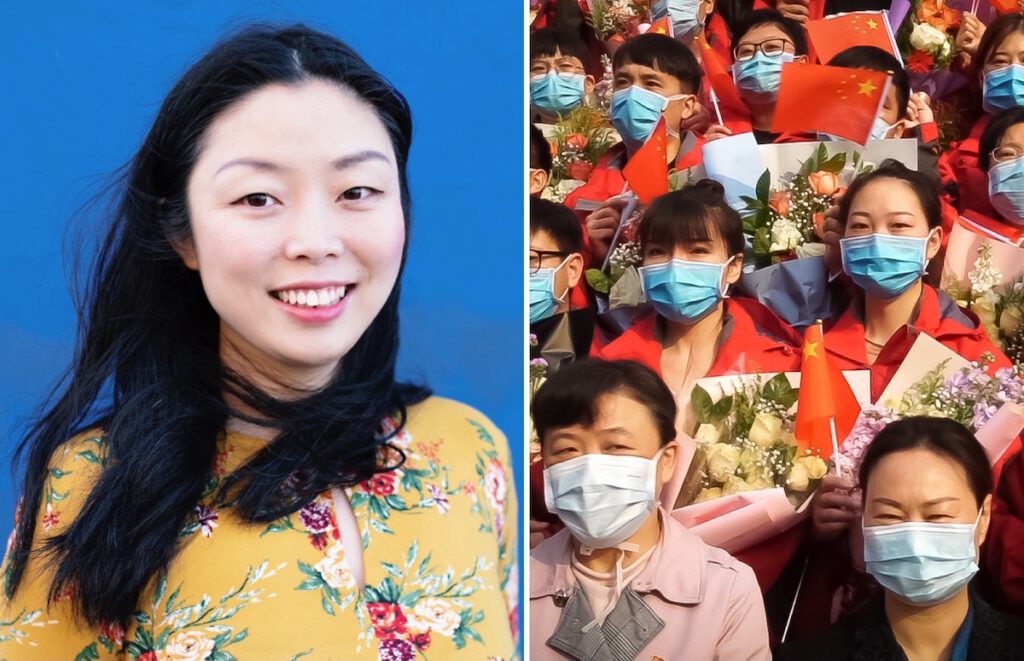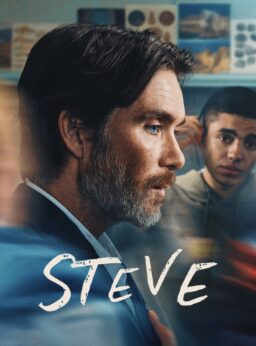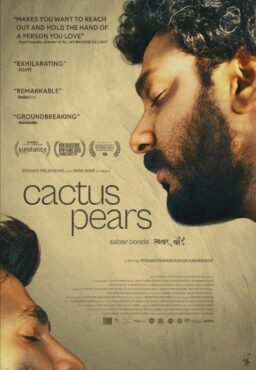“I came to realize that when I first embarked on the project, I only saw the things that I wanted to see, and I think we all do that to a degree. We choose what we believe in.” This is what director Nanfu Wang told me during our first interview at Hot Docs 2017, where her sophomore feature, “I Am Another You,” screened. Who could’ve known how prescient her words would prove to be a mere few years later, as the COVID-19 pandemic would fuse with widespread propaganda to create an unprecedented period of global confusion and division that mankind is still in the midst of processing? When we met in Toronto, Wang was pregnant with her first child, who would go on to be prominently featured in her next two documentaries, “One Child Nation” and now “In the Same Breath,” both of with further affirm her status as one of the best and most important filmmakers working today. Her work serves as a beacon of not only truth but an ability that is every bit as crucial to the survival of our species: empathy.
Winner of the Audience Award this year at SXSW, “In the Same Breath” retraces every destructive step made by the governments and authority figures in both China and the U.S. as the Coronavirus outbreak engulfed the world during the early months of 2020. On January 1st of last year, every news station in China reported that Wuhan Police “arrested eight people for spreading rumors about an unknown phenomena,” despite the fact that the first evidence of the virus could be traced back to December 1st, 2019. Health officials in both countries were fired from their jobs simply for being vigilant in protecting themselves and others from the virus prior to the lockdown. Even Anthony Fauci, the Chief Medical Advisor to President Biden, was telling reporters that U.S. citizens don’t have to wear masks as recently as March 8th, 2020, just days prior to when society as we knew it came to a standstill.
Wang’s film is almost unbearably wrenching at times, such as when a grief-stricken father in China weeps after he is dismissed from the hospital room of his dying son. Yet it is her clear-eyed humanism that makes the experience of watching this film as engaging as it is essential. As news broke two weeks ago that the delta variant had reached Wuhan, the Chinese city where the Coronavirus was first detected, Wang took time to speak with me about why “In the Same Breath” (which premieres on Wednesday, August 18th, on HBO) was her most challenging film to date, the importance of not dismissing those who are protesting the COVID-19 vaccines and why she is uncertain about whether she’ll be able to make another documentary in China.
To me, your four features—“Hooligan Sparrow,” “I Am Another You,” “One Child Nation” and now “In the Same Breath”—could be embraced as one epic film, linked not only through your personal perspective but in how they refer back to one another. How would you say these pictures are spiritually connected?
Well, the one most obvious answer is that I’m the one making them. [laughs] It’s interesting because they all came to me in different ways. I was compelled to make each film for a particular reason, whether it was one character or one issue or a very specific circumstance. So it wasn’t like I was actively searching to make one film that served as a continuation of what I had previously made. It’s only when looking back at them after hearing observations similar to what you just made that I begin to see the thematic connections between the films. A lot of them deal with freedom or holding those in power accountable, while having compassion and empathy toward ordinary individuals. Those happen to be the core themes in all of my films.
I think there are definitely more parallels that can be made between “One Child Nation” and “In the Same Breath,” such as the topics of propaganda and misinformation and how the authorities shape the narrative through utilizing certain tactics. “In the Same Breath” takes all of this one step further. “One Child Nation” examines history that occurred over the course of thirty-six years, and the impact that it left on the present day. “In the Same Breath” documents our current moment, while witnessing how the authority figures in power—in both China and the U.S.—have shaped the narrative and are writing its history. It’s reflective of what’s happening not only in the two countries that are featured in the film, but all around the world. You can almost imagine how the U.S. version and Chinese version of history will be written in history books. I realized that there were huge differences between what they say happened versus what actually happened. That was one of the major motivations for me to start making this film.
Why was this film, as you’ve stated, your most challenging to date? I’m curious what precautions you and your camera operators—two of which are credited as “anonymous”—took when preparing to enter the hospital rooms of those infected with COVID-19.
In terms of getting around the censorship and restrictions in China, this truly was my most challenging film. I feel that in the future, making documentaries in China is going to be more and more challenging if they touch on any sensitive topics—politics as well as social issues. The reasons are not only because the government has tightened its restrictions and censorship, but ordinary people—because of the propaganda and the education they received—have increased their resistance toward the media, especially if they ever hear that it is foreign or from a network that is based outside of China. The government has done a really successful job of painting any member of the media who isn’t from the state-owned TV networks as someone who is trying to sabotage the Chinese government by portraying it negatively.
The precautions that we took on this film were based on the experiences we accumulated while making “Hooligan Sparrow” and “One Child Nation.” All of our communication was encrypted. We never talked on any platform where the communication was not secured. We also backed up our footage on multiple copies so that it could be transferred securely. This project was so collaborative and at the same time, it had so many moving parts—so many different cinematographers, field producers, assistants and researchers—that it became the biggest team I’ve ever worked with. When we delegated the work for the team, we ensured that each person’s task would be very self-contained. If you look at the scope and the nature of the work itself, it wouldn’t be considered subversive or critical in any way, whether they’re filming in the hospital or interviewing a particular person. That way, there would be no issues when the footage was under examination.
It is the editorial decision of how all those different elements are cut together that made the eventual final product critical and analytical. We didn’t let any of our collaborators know what the other crew members were doing—such as what the other camera people were filming—or what the bigger picture would be. The reason for that was to provide reasonable deniability if the authorities questioned them. As for health precautions, we took them extremely seriously. Anybody who filmed inside a hospital had a tutorial and were trained by the doctors and nurses to wear multiple layers, which included masks, gloves and shoe covers. Some of the camera people I contacted had already been filming in hospitals and had learned how to protect themselves. There were specific instructions on how to remove and change their layers, as well as how to sanitize the cameras, the microphone and all the equipment. Everyone who came onboard had to comply with those rules.
To what extent was it difficult to humanize the perspective of those protesting COVID-19 vaccines and other safety measures?
The challenge only existed in how to make people who watch the film feel the same way as I did. It’s always difficult when you have feedback screenings and audience members are like, “What are you doing? Why are you showing them this way?” The challenge lies in translating how I feel so that other people can feel that way too. Of course, this was the first close contact that I ever had with that group of people. I wanted to try to understand how they think and why they think that way, and it really didn’t take long for me to feel empathy. After meeting them and having long conversations with them, you understand that these are just people—like you and me—and we all want the same thing, ultimately. We all want transparency and we all want truth. The difference is what they consider to be the steps that must be made in how to go about acquiring this truth.
The realization that I arrived at is that there is a huge difference between people who consume the narrative versus the people who have the power to create that narrative. You and I may not agree with those groups of protestors, but the question I feel we have to ask is, “How did they get there? What influenced them? What is their background and what is their source of information? Who are the people they are around?” A lot of these protestors are very, very bright and intelligent people, and I don’t think we should be dismissive or condemning toward them in any way. Instead, we should look at the people at the top who create and shape the narrative which spreads out to the hundreds of thousands of people who become the consumers of those narratives.

One of the most troubling aspects of your film is how it shows Anthony Fauci and the CDC were complicit in spreading the very misinformation, at least initially, about COVID-19 that has led people—including members of my own extended family—to distrust the government.
It is true, and I think it’s overlooked. We all like to believe that our world has clear heroes and villains and that the heroes are going to save us after all, but that’s not the reality. It’s dangerous to believe that everything that went wrong during the pandemic was because of the Trump Administration, and now that the election is over, everything is going to be fine, or at least on the way toward improving. Yes, there is truth in that, but that is not what my film is about. “In the Same Breath” is not about COVID-19, but rather, a lot of issues in our society—whether it’s the propaganda, the misinformation, the lack of truth or the lack of transparency from those in authority. All of those issues existed prior to the pandemic and were only compounded by the virus. They will continue to exist after the pandemic, and if we don’t see it that way and believe that all our problems will go away once the pandemic is over—that, to me, is dangerous.
Each of your films contain indelibly haunting imagery, and in the case of “In the Same Breath,” what struck me the most was the footage of balloons being thrust into the air during China’s New Year’s celebrations, a horrific symbol for the virus being spread.
I’m glad you saw the balloons as a metaphor for the virus spreading in the air unknowingly. That was my intention and I’m glad that you could read into it. It was something I felt when I first looked at the footage. In terms of how I came up with the idea of bookending the film with China’s New Year’s celebrations, beginning with the festivities from last year and concluding with those from this year, it’s an interesting story. We were supposed to be picture-locked on January 1st of this year—I believe we were, in fact—but as we got closer to that date, I began wondering what people in China might be doing on that day. Would they still gather and celebrate? I seriously doubted that they would. I thought people would be too traumatized or had somehow learned from the past.
I immediately contacted my collaborators in Wuhan to ask them whether people will be gathering for the New Year’s festivities, and they said, “Yes, they will be.” So I made the decision to go film the celebration. I didn’t know what it was going to be like, and when the camera people sent me the images and photos of what they saw after they arrived there, it was just astonishing. I also felt it was ironic. Ending the film with this footage conveys the message that if all we want is to return to the sense of normalcy that existed before the pandemic, then all the issues that we’re seeing now are going to be even worse. The public celebrations in China on January 1st, 2021 are an example of that.
Do you share the belief powerfully voiced by Chen Qiushi—the Chinese activist who went missing last February after reporting on Wuhan’s coronavirus outbreak—that one must not fear death when speaking truth to power? If so, how have you been able to maintain that over the years?
The fear is always there. Recently, the Chinese government threatened my family, and every time this sort of thing happens, I am unsure about whether I’ll ever be able to make another documentary about China or I’ll be able to go back and visit the country again. If the next project would be a risk that could potentially result in all my family members who are in China getting arrested, I don’t know if I could move forward with it. It’s a really hard decision to make, and that’s the thing with citizen journalists like Chen Qiushi. He had been threatened multiple times, so each step he took, each new event he participated in and each new protest he started was a gamble. He knew it was going to happen one day and that the penalty would be really bad.
Each time, the threats to my family get more and more real. Right now, these threats have been more real than ever. Does it make me pause and wonder whether I should continue the risk? Yes it does, because it’s not about me. If it was just about me and it didn’t involve the people that I love, I probably would’ve cared less. I’m pretty pessimistic about the Chinese government because I think there is no balance within it or any institution, country or organization that can hold it accountable. So I don’t know what the future will be.












